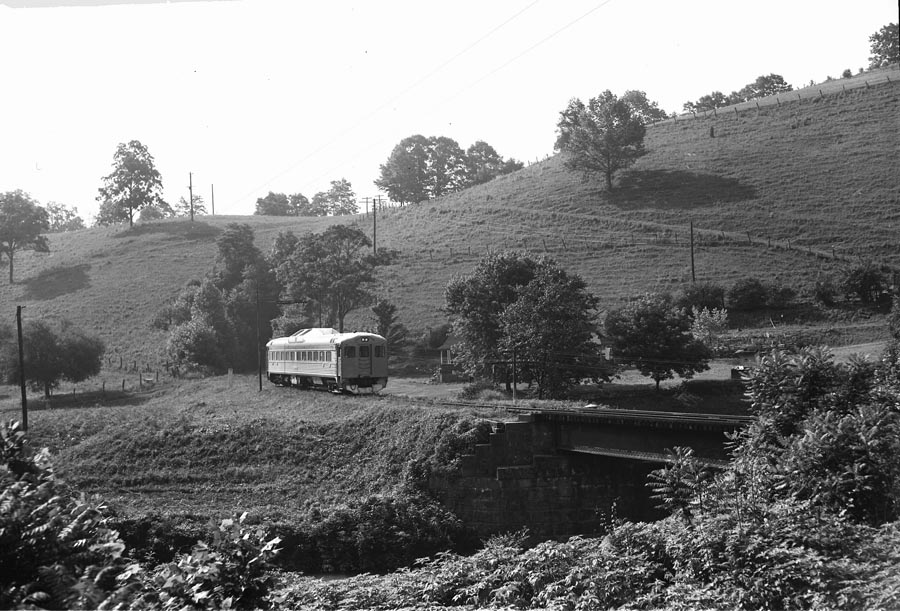Readin', Writin', and Ridin' the Rails
By Bob Withers

The New York Central Railroad (NYC) ran this little Beeliner train from Charleston up Blue Creek and on to Hitop and back, twice daily, carrying children to and from school. Photograph 1954 by Richard J. Cook, courtesy of the Allen County (Ohio) Historical Society.
For a while, they're children again. There are canes, eyeglasses, halting steps, and arthritic twinges. But when precious memories bubble to the surface, the years melt away.
The 20th anniversary Rail Riders' Reunion, which took place last October at the Quick Area Community Center in Kanawha County, attracted 56 people from six states. In times past, they have come from as far off as Washington, Oregon, and California.
Their common bond is that they or their relatives had once ridden trains, not buses, to school. The “children” lived along a 34.4-mile New York Central (NYC) branch line that ran up the Elk River from Charleston, crossed the river at Blue Creek, and ascended up the narrow, twisting Blue Creek territory – which had virtually no roads – for its final 21 miles to Hitop. The railroad was built to haul the products of several coal mines, logging operations, and oil wells and carry passengers between several tiny communities. Trains averaged 15 miles an hour, crossed 52 bridges, and negotiated 120 curves from one end to the other.
In fact, conductor Lee Hill, who started working in 1913, remembered a passenger asking him if the barn on the J.H. Copenhaver farm was the same one she had seen five minutes before.
“Sure is,” Hill told her. “And if you wait just a few seconds longer you will see all of its four sides.”
For decades, the Kanawha County Board of Education's school buses couldn't come anywhere close to the childrens' homes, so the school board paid the fares for up to 200 students each year to ride the branch's passenger trains. Few other passengers accompanied them.
NYC operated two round trips between Charleston and Hitop – one in the morning and one in the afternoon, keyed to the schedules of Blakeley Grade School, Quick Junior High School, and Elk District High School.
At first, the trains were operated by steam locomotives pulling a baggage/mail combination car and a coach. But on Friday, December 29, 1950, a small diesel replaced the steam engines, which in turn was replaced by gas-electric “doodlebug” M-10 and a coach. Steam and diesel locomotives substituted for the M-10 or were called out of Charleston to drag it back to town when it broke down, which was frequently. When the old gas-electric car finally gave up the ghost on April 13, 1953, NYC assigned “Beeliner” M-465 to the run. The Beeliner was a diesel-powered, self-propelled Rail Diesel Car built by the Budd Company, known to locals not only by its marketing monicker but also as the “RDC” or the “KV.”
The car's shiny, fluted aluminum siding added a touch of class to the line and was economical to operate. There was an engine cab at each end, so all the engineer had to do at the end of the line is remove the throttle and carry it with him to the opposite end of the car.
The railroad modified the car to serve all the branch's needs, equipping it with a small express, baggage, and mail compartment and seating for 100 passengers.
In its earliest years, the train ran on Sundays for baseball games between the remote communities or Fernwood Park's fish pond and picnic area at Rock Camp. It also made occasional ambulance and hearse runs. At times law enforcement officers and their bloodhounds rode to one town or another with the populace watching as they boarded again with their captive. The railroad was the way mine guards came to town – and hurriedly departed!
The children started riding the trains in 1925, when the high school opened. A few of those who got on at Hitop disembarked at Blakeley or Quick. The rest went on down to Elkview.
Children boarded the trains at 18 intermediate stops between Hitop and Elkview: Amelia, Blakeley, Wills Hollow, Pond Fork, Kendalia, Middle Fork, Acup (originally Morris), Sanderson, Little Tunnel, Big Tunnel, Coal Ridge (originally Roderick), Quick, Pentacre (originally Carpenter), Coco, Schrader, Three Mile, Oil Siding, and Blue Creek. Fourteen of those stops were represented at the 2012 reunion.
You can read the rest of this article in this issue of Goldenseal, available in bookstores, libraries or direct from Goldenseal.